New York
| |
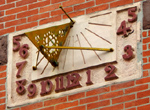 |
Elmira |
New York |
USA |
Vertical Dial |
Dial 811 |
| The white concrete dial face with surrounding dark red Arabic hour numbers is approximately 2 foot tall by 4 foot wide. The hour angles are clean grooves in the concrete. All are easily visible from ground level. Most striking is the steel gnomon painted bright yellow with an ornate central cut-out of a triangle symbolizing the trinity. |
| |
| |
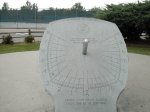 |
Englewood |
Colorado |
USA |
Equatorial Dial |
Dial 510 |
| The Archie Lynn Chase Sundial is an equatorial polar dial. Unlike other monumental polar dials (designed by Erickson Monument Co), the dial face is more of a rounded square than a circular disk. Hours, half hours, quarter hours and five minute lines mark the time from 4am to 8pm. The hour lines are rotated for the site latitude. A steel gnomon rod about 3 inches in diameter casts the shadow. Has a plaque describing the Equation of Time. |
| |
| |
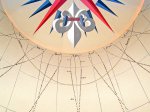 |
Englewood |
Colorado |
USA |
Gnomonic or Projection Dial |
Dial 555 |
| An internal cylindrical dial on the walls of the entrance tower to the Science Building of Kent Denver School. A glass-covered 1/8 inch aperture in the center of ceiling dome projects a spot light onto the inner vertical cylindrical wall of the vestibule. Aluminum strips mark the solar altitude and azimuth. Bronze strips mark the equinox and summer solstice. Bronze and nickel domed nails form the hour analemmas showing Mountain Standard Time with daylight savings time below. The dial design is by science teacher David Potter and architect Paul Hutton proportioned the "Sun Tower" so the summer solstice noon mark would be at the bottom of the cylindrical wall. Artwork on the ceiling includes a hand-painted winking "Sol" in a 24 point compass rose. |
| |
| |
 |
Enid |
Oklahoma |
USA |
Equatorial Dial |
Dial 351 |
| A striking stainless steel equatorial dial 6 ft tall, 4 ft wide, and 6 ft deep. The equatorial ring is more than 2 ft wide. The dial can be used as a simple equatorial dial, reading the hour from a shadow cast by the steel wire gnomon aligned to the polar axis. However a bead nodus located in the middle of the wire casts its shadow onto the equatorial ring as well. An analemma on an arched plate is set to slide along the equatorial ring in a track. By sliding the plate to a position where the nodus shadow falls on the analemma for the day of year, the dial corrects for the Eot. Markers on the analemma plate point to the correct time at the edge of the ring. The top of the ring is inscribed for Central Standard Time and the bottom is inscribed for Central Daylight Time. Overall, the sundial is accurate to about a minute any day of the year. The analemma was computed by Lt Col Bill Welker, USAF and the dial was funded by McCasland Foundation. |
| |
| |
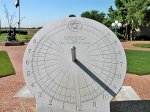 |
Euless |
Texas |
USA |
Equatorial Dial |
Dial 602 |
| A granite and stainless steel equatorial dial approximately 6 feet high. Equation of time and user information are shown on a granite lab in front of the dial. |
| |
| |
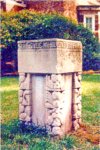 |
Evanston |
Illinois |
USA |
Horizontal Dial |
Dial 298 |
| This was once a horizontal sundial of unknown construction commissioned by the Works Progress Administration. The dial has been removed and only a 24x24 inch pedestal remains, now adorned by a flower pot. |
| |
| |
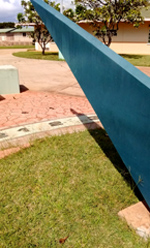 |
Ewa Beach |
Hawaii |
USA |
Horizontal Dial |
Dial 1011 |
| This is a large horizontal dial with a blue metal gnomon. At 21 deg latitude, the gnomon's low angle is distinguishing. Along the perimeter of half circle are Arabic numbers marking the hours from 6am to 6pm set between two concrete chapter rings. Just beyond the dial to the north is a an concrete bench that arcs across the 10am-2pm shadow line. The dial and bench are situated at one end of a long green corridor between the school buildings. |
| |
| |
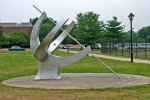 |
Ewing |
New Jersey |
USA |
Compound Dial |
Dial 231 |
| A combination horizontal and equatorial dial. Stainless steel equatorial ring is 8 feet wide x 10 feet high. Equatorial gnomon extends to cement face of horizontal dial. Bronze plaque provides a table of corrections for EOT and longitude. Identified as the William H. Hausdoerffer Sundial to honor Dr. Hausdoerffer, Class of 1936, Professor Emeritus of Mathematics, Department Chairman, Dean of Men, TSC Athletic Hall of Fame, Alumni Executive Board and adviser to many groups, serving from 1940 to 1979. |
| |
| |
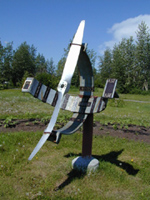 |
Fairbanks |
Alaska |
USA |
Equatorial Dial |
Dial 998 |
| This equatorial sundial uses the shaft hole of an old airplane propeller as a nodus to cast a sun beam spot on the equatorial band. The arms are made from pieces cut from an unused pipe section intended for an oil pipeline. The dial appears to have time zone compensation. The hour marks are labelled for both Standard and Daylight Saving Time (with no minor marks). The propeller hole shines light onto the words "summer", "equinox", and "winter". |
| |
| |
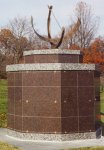 |
Fairfax |
Virginia |
USA |
Equatorial Dial |
Dial 432 |
| This bronze equatorial dial is about four feet in diameter with a 6 inch equatorial band containing raised Roman hour numbers from 5am to 7pm. The band is graduated every ten minutes and is offset by approximately 8 minutes to read Eastern Apparent Time. The gnomon is a simple arrow without nodus and the dial does not have an analemma. The octagonal dial base is made of brown marble panels approximately 5 feet high with a smaller octagon on top approximately 1 foot high that supports the dial. Each octagon is capped with thick granite. The base is a mausoleum, with alternate octagonal sides each containing 8 crypts. |
| |
| |
 |
Fairport |
NY |
US |
Analemmatic Dial |
Dial 904 |
| This analemmatic sundial was created in 2017, 200 years after construction on the Erie Canal began. Artist Vanessa Sheldon "created the sundial [hour marks] using salvaged canal stones [from Erie Canal Lock 58]." According to WHAM News the sundial was unveiled by the Fairport Industrial Development Agency and Fairport Public Art Committee. Funding for the project was partially paid for by a $50,000 matching grant through the Finger Lakes Regional Economic Development Council. |
| |
| |
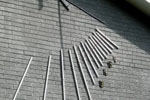 |
Falls Church |
Virginia |
USA |
Vertical Dial |
Dial 787 |
| A large vertical dial on the southwest brick wall of a private home. The hour lines are square PVC stock. Arabic hour numerals for noon to 7 PM are brass plated figures mounted on brass plaques. The dial declines 54 degrees from south to west. The ends of the hour lines indicate the solstices except for several long summer hour lines. The equinoctial points are marked by red glass inserts on the hour lines. |
| |
| |
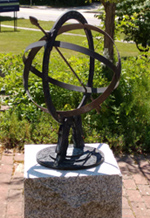 |
Falmouth |
Maine |
USA |
Armillary Sphere |
Dial 829 |
| This bronze armillary sundial is about 18 inches in diameter. The prime meridian ring is embossed with an intricate design. A different designed with forward and backward "S" adorns the exterior of the equatorial ring while the interior has embossed Roman numerals for the the hours. The 6-hour ring is plain and there is no horizontal ring. The arrow gnomon rod is at the correct slope but the dial is free to turn on its base so that it is not oriented north. |
| |
| |
 |
Farmington |
Utah |
USA |
Horizontal Dial |
Dial 783 |
| A 28 x 20 x 2 inch sandstone horizontal dial with a 1/2-inch thick, hand-tooled copper gnomon. Dial face has Arabic numerals and hour lines corrected for local longitude. Dial was hand carved with carbide chisels and maul but using techniques and natural stone used to create ancient Native American petroglyphs found in the southwest USA. Dial is mounted 2 inches above a sandstone base weighing 400 pounds by brass leveling pins; this mounting makes the dial appear to "float" above the stone base.
A "Desert Varnish" finish has been applied to the dial face using a natural process that mimics what naturally happens to exposed sandstone over several thousands of years. The natural color of the stone is exposed by the carving process to create a color contrast as might be seen in a Native American petroglyph.
Dial is located in the front yard of a private residence. Viewing can be arranged by contacting the owner by email at theoperativemason@gmail.com |
| |
| |
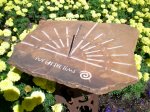 |
Farmington |
Utah |
USA |
Horizontal Dial |
Dial 698 |
| A 20x18 inch sandstone horizontal dial with a 4 inch work-hardened copper gnomon. Dial face has hour lines with Arabic numerals. The hour lines and spiral sun symbol were hand carved using techniques and natural basalt stone tools used to create ancient Native American petroglyphs found in the southwest USA. An ogham character representing the designer's initials is carved in the lower left. Dial is placed on a welded steel pedestal with laser cut images typical of petroglyphs found in Utah. Dial pedestal is welded steel with laser cut images of petroglyphs typical of those in Utah.
Dial is located in the back yard of a private residence. Viewing can be arranged by contacting the owner by email at theoperativemason@gmail.com |
| |
| |
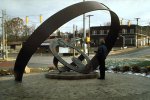 |
Farrell |
Pennsylvania |
USA |
Sculpture/Artwork |
Dial 519 |
| "Rising Rings" is a cast iron band 11 feet high by 17 feet in diameter with a hole that casts a beam of light onto a central ring monument on the equinoxes. The dial was commissioned by Dr. Swraj Paul, a steel mill owner, to honor his daughter Ambika who died in 1968 of leukemia at age four. This monument honors the inspiration her joy of life instilled in her father. At the central of the dial is a cast iron ring that holds a bronze image of her that is illuminated for several days twice a year. On two dates, Ambika's birthday and the anniversary of the mill's re-opening the noon sunlight passes through the circular opening in the larger ring and strikes markers on the inner ring. Miklos Simon created the portrait of Ambika mounted on the smaller ring. |
| |
| |
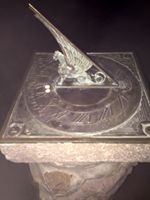 |
Flagstaff |
Arizona |
USA |
Horizontal Dial |
Dial 2 |
| Small bronze horizontal dial with a coarse chapter ring and Roman hour numerals. The gnomon is done as a gryphin. It was a gift from the observatory staff to Dr. Lowell. In a thank you note to his staff, Lowell stated, "Nothing could have pleased me more than that Sundial clothed with its mountain cloak, symbolic of when the sun always shines. It shall be inscribed with all your names and set up on the top of Mars Hill." The original square stone base is replaced by an irregular column of stone and concrete. The square plinth at top still supports the small horizontal dial. |
| |
| |
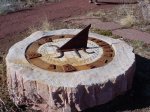 |
Flagstaff |
Arizona |
USA |
Horizontal Dial |
Dial 313 |
| This cast iron horizontal dial is set in a 6 foot diameter limestone base 2 feet off the ground. The interior region of the dial face is a white tile mosaic. The gnomon has pictures of buffalo and a horned lizard done in relief. The edge of the dial is a cast iron ring, upon which are four cardinal points and hour markers from 5am to 7pm, likewise in cast iron. The dial is corrected to mountain standard time. |
| |
| |
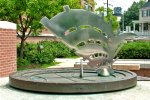 |
Flemington |
New Jersey |
USA |
Horizontal Dial |
Dial 355 |
| Horizontal dial with an intricately hand cut stainless steel gnomon with a cast bronze dial face. The shadow casting style is the lower edge of the large gnomon. A second short gnomon indicates solstice and equinox dates. Dial sits atop a 700 lb stone pedestal base. |
| |
| |
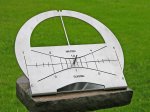 |
Flemington |
New Jersey |
USA |
Compound Dial |
Dial 565 |
| A 12x9-inch combination equatorial and polar dial made of stainless steel and titanium. Solstice and equinox lines are shown on the polar dial face. This sundial is located in the park behind the old county courthouse where the Lindburgh baby kidnapping trail was held. |
| |
| |
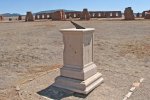 |
Fort Union |
New Mexico |
USA |
Compound Dial |
Dial 393 |
| A 2 foot square stone horizontal dial on a four foot high stone pedestal with vertical dials on its faces. This dial has been removed, replaced and relocated several times. The original gnomon was lost and replaced with an incorrect 45° gnomon, which has been replaced again with a steel gnomon that appears to be at slightly less than the correct latitude angle. All vertical dial gnomons are missing. The dial and a nearby inscribed stone are on the grounds of the Third Fort Union (1863-1891). The stone dial surfaces are worn from weather, but the Arabic hour numerals are still visible. |
| |
| |
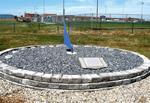 |
Fort Wayne |
Indiana |
USA |
Horizontal Dial |
Dial 677 |
| A 15 foot diameter stone and cement horizontal dial with a painted steel gnomon. 6 AM to 6 PM hour markers have Arabic numerals. Interior area of dial is filled with crushed rock. A plaque provides EOT and longitude corrections and instructions. This dial was an Eagle Scout project built for this elementary school for use in science lesson plans. Dial sits within a two-course stone perimeter pedestal. |
| |
| |
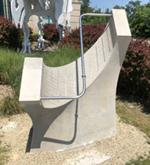 |
Fort Wayne |
Indiana |
USA |
Equatorial Dial |
Dial 956 |
| According to WPTA-21 news, "This odd looking nine thousand pound chunk of limestone is a scientific instrument, a sundial unlike any you’ve seen." It is an equatorial dial but with a parabolic shaped equatorial for telling time. The reason for the odd shape? "The shadow cast by a stainless steel bar moves across the dial face telling time not just in Fort Wayne but also half a world away in Takaoka, Japan, one of Fort Wayne’s Sister Cities. A half-size version of the same sundial in Takaoka does the same thing." |
| |
| |
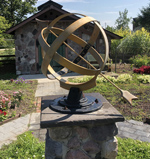 |
Fort Wayne |
Indiana |
USA |
Armillary Sphere |
Dial 986 |
| This is a 32 inch diameter armillary dial made of painted steel. The gnomon is a classic arrow at a 41 deg angle. The equatorial band is painted black with bronze colored Roman numerals indicate the hours from 6 AM to 6 PM. The dial is mounted on a field stone plinth. |
| |
| |
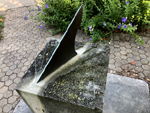 |
Fort Wayne |
Indiana |
USA |
Horizontal Dial |
Dial 987 |
| This horizontal dial is 16 inches square, made of limestone with a brass gnomon. The gnomon angle is 30 deg, certainly not correct for the dial's latitude of 41 deg. Nonetheless, it appears that the dial was made for its site as the gnomon and dial numbers are rotated on the square to point due north. Arabic numerals mark time by hours from 8 am to 6 pm, with raised hour lines extending toward the gnomon. The equation of time is shown as a graph on one side of the plinth. The limestone is deteriorating with age and is now covered with lichen. The 3 and 4 pm numbers are nearly obliterated and in several more years many of the other hour numbers will vanish. The dial is situated under trees with little opportunity to see the sun. |
| |
| |
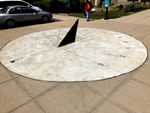 |
Fort Wayne |
Indiana |
USA |
Horizontal Dial |
Dial 988 |
| This is a large 20 foot diameter horizontal dial embedded in the cement sidewalk. Brass hour lines extend from the edge of the circular dial to the toe of the gnomon. The gnomon itself is a brass triangle, tarnished except for its tip that is frequently rubbed by visitors. Arabic numerals mark time by hours from 6 am to 6 pm. |
| |
| |
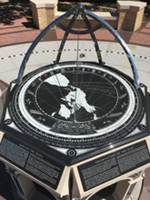 |
Fort Worth |
Texas |
USA |
Horizontal Dial |
Dial 937 |
| This elegant horizontal dial is more than just a horizontal sundial. The designer, William Andrewes refers to this instrument as a "longitude dial". First designed by Franz Ritter in 1607, the dial plate contained a gnomonic map projection. The TCU dial has a map projection centered on Fort Worth. The dial is about 48 inches in diameter, made of black granite with excellent inset white marble for dial lines and a chapter ring delineated to the minute. An outer chapter ring gives the months of the year and corresponding minute correction of the Equation of Time. The gnomon is a thin rod with nodus to cast shadows on the map's tropic of Cancer, equator, and tropic of Capricorn. Other day lines record significant dates for Texas Christian University. |
| |
| |
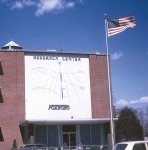 |
Foxboro |
Massachusetts |
USA |
Vertical Dial |
Dial 43 |
| Very large vertical dial mounted above the entrance to the Foxboro Research Center. With solstice and equinox lines and a noon analemma. |
| |
| |
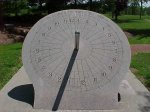 |
Frankenmuth |
Michigan |
USA |
Equatorial Dial |
Dial 194 |
| This monument sundial is an Erickson equatorial polar dial 6 feet in diameter made of light granite with a 3 inch steel rod as gnomon. Time is graduated by hour, half-hour, quarter hours and 5 minute marks over 24 hours. Noon is at the bottom, matching the 105 degree meridian. Designed to be read from the upper surface in Spring/Summer, from the under side in Fall/Winter. Unlike other Erickson dials, the Equation of Time plaque is presented in a circular arc on the ground. |
| |
| |
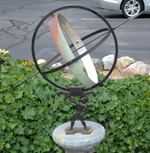 |
Frankenmuth |
Michigan |
USA |
Armillary Sphere |
Dial 896 |
| This is a mass produced armillary dial held at the latitude of Frankenmuth by the statute of a boy with raised arm. All this sits on a pedestal with a Greek motif. The meridian circle made of iron is about 2 feet in diameter. The equatorial band is about 3 inches wide with some corrosion present. Inside the equatorial there appears to be an aluminum interior band of Arabic numbers riveted to the equatorial. Hours and half hours are marked by dot bumps in the aluminum. There is an iron latitude ring for decoration. The bronze gnomon extends the meridian circle with both an arrow point and feathered tail. |
| |
| |
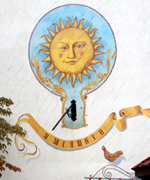 |
Frankenmuth |
Michigan |
USA |
Vertical Dial |
Dial 897 |
| The dial is elegantly painted on the south wall declining 30 deg west. Dial shows daylight savings time using dark red Roman numerals on a golden ribbon banner. The gnomon is a simple rod held firmly to the wall by an ornate bracket. Above the dial is a large smiling sun surrounded by a sky blue band. |
| |
| |
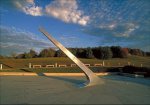 |
Frankfort |
Kentucky |
USA |
Horizontal Dial |
Dial 90 |
| The Kentucky Vietnam Veterans Memorial features a 7090 square foot plaza with a monumental 86x68 foot horizontal dial of granite slabs with a 14.6 foot high gnomon of welded stainless steel plates. |
| |
| |
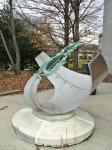 |
Franklin Center |
Pennsylvania |
USA |
Equatorial Dial |
Dial 139 |
| A modernistic equatorial dial about 6 feet in diameter. The analemma shaped gnomon casts standard time onto a wide metal semicircle band. The hours with 10-minute marks are inscribed on the center of the equatorial band. This unique sundial tells the time, indicates the approximate day of the month and projects the zodiacal constellation signs as they are aligned with the sun and the earth in this era. It is accurate to within two minutes. |
| |
| |
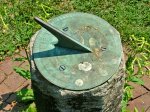 |
Fredericksburg |
Virginia |
USA |
Horizontal Dial |
Dial 193 |
| A 7 inch diameter brass horizontal dial with 3.5 inch high brass gnomon on a weathered octagonal stone pedestal. Reported to be contemporary with Mary Ball Washington's occupancy of this house in the 1780s. Dial sits atop a stone pillar. |
| |
| |
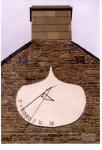 |
Fredericton |
New Brunswick |
Canada |
Vertical Dial |
Dial 397 |
| A vertical declining dial 7 x 7 feet with parged cement face and 5 foot wrought iron gnomon. Plaque on wall reads "The sundial at the top of this wall is a faithful reconstruction of the original which Frederictonians used during the 1800s and early 1900s. The shadow cast by the gnomon (style) onto the dial accurately displays local apparent solar time." An equation of Time is included on the plaque to determine mean time. The date of the original construction of this sundial is not known, but the Soldiers Barracks were built in 1826. The dial was restored in 1992. |
| |
| |
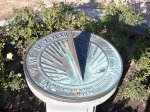 |
Fullerton |
California |
USA |
Horizontal Dial |
Dial 529 |
| This 18-inch cast bronze horizontal dial is located in front of Heritage House, the relocated office and home of early Fullerton physician Dr. George C. Clark. The gnomon edge is tapered to a single style. Dial sits atop a cylindrical cast concrete pedestal 28-inches high. |
| |
| |
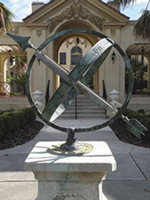 |
Gainesville |
Florida |
USA |
Armillary Sphere |
Dial 866 |
| As the tour pamphlet states,"The striking armillary sphere sundial, donated in 1986 by the Gowan family, terminates an important sight line from the Turtle Court. Two Washingtonia palms stand like tall sentries as visitors cross the arcade from the Turtle Court to the sundial." The bronze dial about a meter in diameter has a 3-inch bronze equatorial band with Roman numeral hour marks on the interior and signs of the zodiac on the exterior. The gnomon is a arrow rod that fits the "massiveness" of the sundial. All sit on an ornate granite pedestal that in turn sits on a square dais elevated about 6 inches from the ground. |
| |
| |
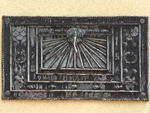 |
Gainesville |
Florida |
USA |
Vertical Dial |
Dial 869 |
| The oblong 28 inch long x 14 inch high vertical dial appears to be cast aluminum, painted black, but with much of the paint worn off. The dial plate is surrounded with a motif of decorative fish, star fish, shells and scales. The hour lines are most peculiar. The lines are numbered from 7am to 5pm, but there are two more morning and evening hour lines, none of which are horizontal that would be expected for 6am and 6pm. In laying a proper set of hour lines for latitude 29.658 on top of a photograph of the dial, the hours from 9am to 3pm appear nearly correct. The 8am and 4pm hour lines appear at what is really 8:30/3:30, the 7am and 5pm hour lines appear at what is really 8:00/4:00. The last two dial hour angles for morning or evening are totally irreconcilable. The brass gnomon, in the shape of a downward pointing arrow, is bent, but perhaps more disconcerting is that it is mounted on a pivot, indicating that it can be moved to different latitudes. The dial, although decorative, certainly is not a worthy timepiece. |
| |
| |
 |
Gaithersburg |
Maryland |
USA |
Polar Dial |
Dial 51 |
| Briggs Commemorative Sundial. One of the more complex and elaborate ones in the US. The dial plate lies parallel to the earth's axis of rotation. The dial has three gnomons. The upper and lower point out Eastern Standard time, the middle one indicates local apparent (solar) time throughout the year. A copy of the brochure is in the NASS Archives. |
| |
| |
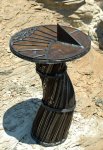 |
Gallup |
New Mexico |
USA |
Horizontal Dial |
Dial 568 |
| An 18 inch diameter horizontal dial of welded steel with a naturally weathered rusty brown finish. The hour lines are corrected for longitude and summer and winter solstice lines are shown. |
| |
| |
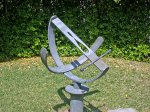 |
Galveston |
Texas |
USA |
Equatorial Dial |
Dial 318 |
| This is an equatorial dial 3 x 4 feet tall, set up for the latitude and longitude of Galveston Texas. Corrections for the Equation of Time are cut as an analemma into the broad gnomon that rotates on a polar rod. The Equatorial time ring has hour lines viewed as standard time or DST at 5 minute intervals. |
| |
| |
 |
Gastonia |
North Carolina |
USA |
Horizontal Dial |
Dial 649 |
| A 56 inch horizontal dial of stone masonry with wrought iron gnomon. Dial center filled with crushed rock with Roman numerals on perimeter stones. Dial is longitude corrected to EST and the EOT correction is shown on an adjacent landscape stone.
Dial is on private property but can be seen from the public street. For closer viewing, contact owner. |
| |
| |
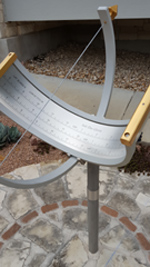 |
Georgetown |
Texas |
USA |
Equatorial Dial |
Dial 1092 |
| A brilliant equatorial dial, constructed of stainless steel, aluminum, and gold-plated brass. Scales for local apparent time, Central Standard time, and Central Daylight time where the Equation of Time on a plaque fixed to the meridian circle. Dial mounting incorporates a unique gimbal to allow precise adjustment of N-S alignment and a meridian ring clamp with plate that mounts to the pedestal pole using adjustment bolts. |
| |
| |
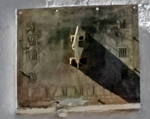 |
Georgetown |
District of Columbia |
USA |
Vertical Dial |
Dial 798 |
| A vertical dial, perhaps one foot square, above the front door of the Georgetown University Astronomical Observatory (the Hayden Observatory). The dial face has Roman hour numerals near its perimeter. |
| |
| |
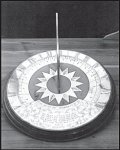 |
Gettysburg |
Pennsylvania |
USA |
Horizontal Dial |
Dial 699 |
| An elaborate gold-colored horizontal dial located on the front lawn of the Eisenhower National Historical Site. The dial was a gift of the National Watch and Clock Collectors. Dial face includes hour lines with Roman hour numerals and a poetic verse describing time. |
| |
| |
 |
Gettysburg |
Pennsylvania |
USA |
Horizontal Dial |
Dial 700 |
| A hexagonal bronze horizontal dial located on the rear lawn of the Eisenhower National Historical Site. The dial was a gift of the Radio and Television Correspondents Association. Dial face includes hour lines with Roman hour numerals and the inscription Tempus Fugit. The dial and a small plaque are mounted on a 120 mm artillery shell. |
| |
| |
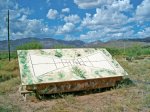 |
Gila |
New Mexico |
USA |
Polar Dial |
Dial 541 |
| An 8x4 foot painted plywood polar dial. Contact owner M. Cuff for access. |
| |
| |
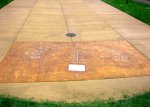 |
Glenwood Springs |
Colorado |
USA |
Analemmatic Dial |
Dial 576 |
| An 11x15 foot poured concrete human analemmatic dial with Standard and DST numerals, seasonal markers and an EOT plaque. The dial is located on the playground of an elementary school. |
| |
| |
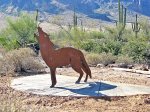 |
Gold Canyon |
Arizona |
USA |
Horizontal Dial |
Dial 657 |
| Built as an Eagle Scout project, this 10 x 5 foot semicircular concrete and steel dial features a 3 foot tall figure of a coyote as the gnomon. The tip of the coyote's nose functions as a point-in-space gnomon. The figure is placed well forward, limiting the times and dates the nose-tip shadow will fall within the hour circle to about 9 am to 3 pm on dates near the summer solstice. |
| |
| |
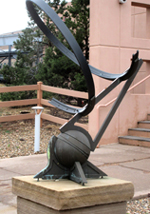 |
Golden |
Colorado |
USA |
Reflective Equatorial |
Dial 855 |
| This dial is one of Bill Gottesman's uniquely designed Renaissance dials of cast and structural bronze with a 27 inch diameter time telling helix whose axis is aligned to the celestial-north pole. Time is told by a focused beam of light from a long cylindrical unsilvered mirror situated on that N-S axis, reflecting sunlight into a slit of light onto the helix, telling time throughout the day. A sliding time scale within the helix is adjusted for longitude, date's equation of time correction and daylight saving time. Once this scale is adjusted for date, the dial shows civil (local clock) time with an accuracy of under one minute. The dial base is cast bronze that allows adjustment for latitude and is placed on a sandstone plinth. |
| |